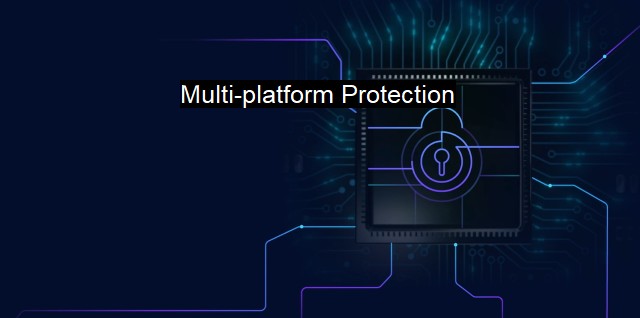What is Multi-platform Protection?
The Importance of Multi-Platform Protection in Cybersecurity: Safeguarding Your Sensitive Data, Across All Devices and Platforms
Multi-platform Protection is a term coined in the field of cybersecurity referring to a plethora of high-end security services and solutions specifically designed to deliver full spectrum security to IT environments operating across different platforms.Traditionally, cybersecurity systems protected different platforms independently, focusing on maintaining security on single-function or single-platform applications. with the integration of applications, technology development and extensive digitization across various sectors, cybersecurity threats have evolved and increased significantly. They are no longer confined only to specific platforms or systems. This has consequently necessitated the need for a more comprehensive kind and level of protection, paving the way for the implementation of multi-platform protection.
Adopting Multi-platform Protection has therefore become a crucial requirement for any individual and business across the world. With the advent and increasing prevalence of usage of remotely accessed platforms, 'Internet of Things' devices and cloud-based services, the traditional boundaries defending platforms and systems have been disrupted. This disruption has directly given a green light to the various forms of sinister cyber threats and attacks. To safeguard against these increasing multi-platform threats, diverse businesses, industries, and individuals are now adopting and implementing multi-platform protection solutions to fully secure their digital footprint.
Multi-platform Protection primarily focusses on securing multiple operating systems and computing platforms susceptible to cyber threats which include traditional office desktops, mobiles, tablets, Windows, MacOS, Linux and Android among others. Typically, a secure Multi-platform Protection solution should not only provide consistent and reliable security across all systems/devices but should also provide a centrally-held administration and monitoring system. This centralized protection should be extensively proficient in tracking, visualizing, and combating the multitude of cyber threats across the board.
Therefore, a well ingrained multi-platform protection protocol both prevents and mitigates cyber threats, ranging from viruses, worms, Trojans, ransomware to advanced persistent threats (APTs). Every attempt at intrusion is identified, and any penetration of the system is allowed only after adequate verification and validation via the secure multi-platform protection system.
Multi-platform protection safeguards every end-user device, irrespective of the type or medium of usage, adding security at numerous sensitive touchpoints where a threat can easily penetrate the system. This multi-level defense often features firewalls, intrusion prevention system (IPS), secure web gateways, advanced threat detection, and remediation features.
Apart from offering protection to the multi-system environment, multi-platform protections also deliver a seamless and consistent experience to end-user, regardless of the platform, device or architecture they use. Equally, multi-platform protection can be cost effective as it streamlines and unifies IT security, making threat identification, investigation, and response quicker and more efficient.
Lastly, Multi-platform Protection prides itself in delivering adaptable and cut-through security to all platforms and systems. This move towards universal security ensures that businesses, irrespective of their size and nature, and users with varied usage can seamlessly collaborate with comfort and place their trust over their technology system without fear of falling victim to cyber threats.
Multi-platform Protection is a holistic approach towards cybersecurity. It secures different platforms through a central control providing an unhindered and seamless experience to all users converting any traditional security system into a forward-looking security shield. This protection is not only necessary, it is pivotal in today's world where threats are ever changing and increasing. There are no longer any boundaries or safe havens within digital landscape. It is only through advanced, forward-looking multi-platform protection that we can hope to counteract these threats and secure our digital universe.

Multi-platform Protection FAQs
What is multi-platform protection?
Multi-platform protection is a type of cybersecurity measure that provides security against malware, viruses, and other cyber threats across multiple platforms or operating systems. It ensures that all devices within an organization are protected regardless of the operating system they use.What are the benefits of using multi-platform protection?
The main benefit of using multi-platform protection is that it provides a comprehensive security solution that covers all devices and operating systems within an organization. It simplifies the management of cybersecurity measures and ensures that all devices are protected against cyber threats. It also reduces the risk of cyber attacks and data breaches by providing a layered approach to security.What types of devices can be protected using multi-platform protection?
Multi-platform protection can be used to protect a variety of devices, including desktop computers, laptops, mobile devices, and servers. It can also be used to protect a variety of operating systems, including Windows, Mac, Linux, Android, and iOS.Is multi-platform protection more expensive than traditional antivirus solutions?
Multi-platform protection can be more expensive than traditional antivirus solutions, but it provides a more comprehensive security solution that covers all devices and operating systems within an organization. It also simplifies the management of cybersecurity measures and reduces the risk of cyber attacks and data breaches. The cost of multi-platform protection varies depending on the number of devices and the level of protection required.| | A | | | B | | | C | | | D | | | E | | | F | | | G | | | H | | | I | | | J | | | K | | | L | | | M | |
| | N | | | O | | | P | | | Q | | | R | | | S | | | T | | | U | | | V | | | W | | | X | | | Y | | | Z | |
| | 1 | | | 2 | | | 3 | | | 4 | | | 7 | | | 8 | | |||||||